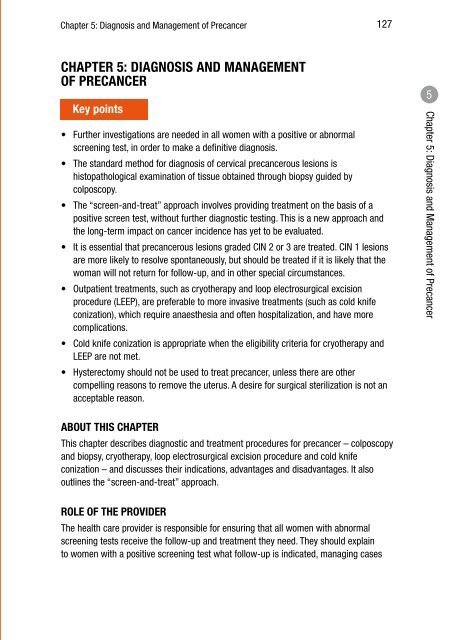CHAPTER 4: SCREENING FOR CERVICAL CANCER
CHAPTER 4: SCREENING FOR CERVICAL CANCER
CHAPTER 4: SCREENING FOR CERVICAL CANCER
Create successful ePaper yourself
Turn your PDF publications into a flip-book with our unique Google optimized e-Paper software.
Chapter 5: Diagnosis and Management of Precancer 127<strong>CHAPTER</strong> 5: DIAGNOSIS AND MANAGEMENTOF PRE<strong>CANCER</strong>Key points• Further investigations are needed in all women with a positive or abnormalscreening test, in order to make a definitive diagnosis.• The standard method for diagnosis of cervical precancerous lesions ishistopathological examination of tissue obtained through biopsy guided bycolposcopy.• The “screen-and-treat” approach involves providing treatment on the basis of apositive screen test, without further diagnostic testing. This is a new approach andthe long-term impact on cancer incidence has yet to be evaluated.• It is essential that precancerous lesions graded CIN 2 or 3 are treated. CIN 1 lesionsare more likely to resolve spontaneously, but should be treated if it is likely that thewoman will not return for follow-up, and in other special circumstances.• Outpatient treatments, such as cryotherapy and loop electrosurgical excisionprocedure (LEEP), are preferable to more invasive treatments (such as cold knifeconization), which require anaesthesia and often hospitalization, and have morecomplications.• Cold knife conization is appropriate when the eligibility criteria for cryotherapy andLEEP are not met.• Hysterectomy should not be used to treat precancer, unless there are othercompelling reasons to remove the uterus. A desire for surgical sterilization is not anacceptable reason.5Chapter 5: Diagnosis and Management of PrecancerABOUT THIS <strong>CHAPTER</strong>This chapter describes diagnostic and treatment procedures for precancer – colposcopyand biopsy, cryotherapy, loop electrosurgical excision procedure and cold knifeconization – and discusses their indications, advantages and disadvantages. It alsooutlines the “screen-and-treat” approach.ROLE OF THE PROVIDERThe health care provider is responsible for ensuring that all women with abnormalscreening tests receive the follow-up and treatment they need. They should explainto women with a positive screening test what follow-up is indicated, managing cases
















